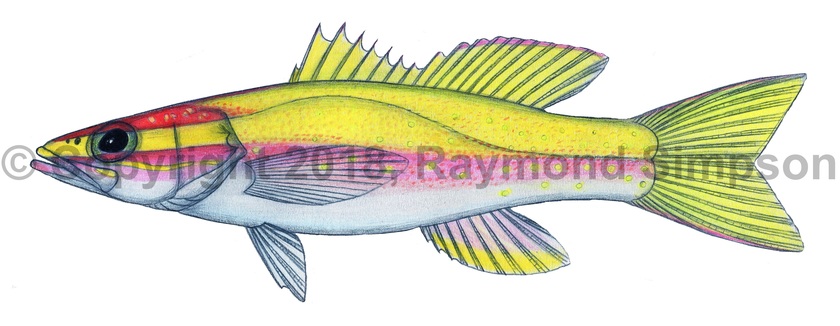
Common Name
Yellow-spotted Golden Bass
Year Described
Baldwin & Johnson, 2014
Identification
Dorsal Fin: IX, 11
Anal Fin: III, 8.5
Pectoral Fin: 14-15
Pelvic Fin: I, 5
Gill Rakers: 17-19 (first arch)
Lateral Line Scales: 47-48
Vertebrae: 24 (10 precaudal, 14 caudal)
Body elongate, compressed, and robust. Body depth 20-24% SL. Head pointed. Forehead profile straight. Eye moderate to large (7.8-9.4% SL). Mouth extends to rear half of orbit. Lower jaw projects. Rear corner of maxilla with a blunt ventral projection. Preopercle not serrated. Opercle with one stout middle spine and two accessory spines. Spiny and soft dorsal fins obviously connected by a membrane, with a weak notch between them. Dorsal, anal and caudal fin with rounded or slightly falcate tips. Caudal peduncle strong. Tail slightly forked with bluntly rounded lobes. Body and entire head with small ctenoid, deciduous scales. Fin membranes scaled.
Larvae with seven filamentous spines (all others have only 2).
Color
Body pale rose to bluish-white with a broad yellow wash over the dorsal half of the body. Head and nape usually brighter rose to red fading behind the head into the yellow dorsum. A yellow band passes through eye from snout to gill cover. A second thinner yellow band often runs parallel under it. Sides of body with random scattered small bright yellow spots. Belly white. Dorsal fins bright yellow. Caudal fin yellow with thin reddish margins. Anal and pelvic fins translucent with a yellow wash anteriorly.
Size
Maximum size to 104mm SL.
Habitat
Deep reefs and rocky area (105-229m).
Range
Scattered records from the Bahamas to the S. Caribbean Sea.
References
Baldwin, C. C., & G. D. Johnson. 2014. Connectivity across the Caribbean Sea: DNA barcoding and morphology unite an enigmatic fish larva from the Florida Straits with a new species of sea bass from deep reefs off Curaçao. PloS One, 9(5), e97661.
Baldwin, C. C., & Robertson, D. R. 2014. A new Liopropoma sea bass (Serranidae, Epinephelinae, Liopropomini) from deep reefs off Curaçao, southern Caribbean, with comments on depth distributions of western Atlantic liopropomins. ZooKeys, (409), 71.
Other Notes
The genus Chorististium had been erected in the past for these smaller Liopropoma with more separated dorsal fins (rubre, carmabi, mowbrayi, eukrines in our area). The genus Pikea was used for larger Liopropoma with notched but noticeably connected dorsal fins (aberrans, olneyi, santi in our area). Recent phylogenetic work shows Liopropoma is paraphyletic with the inclusion of Bathyanthias in the phylogeny, so they will eventually all be lumped into Liopropoma or several new genera will be proposed for the different clades.
Most closely related to Liopropoma aberrans, L. eukrines, and L. santi genetically. The only species in the region with 9 dorsal spines, a weak dorsal notch, and a yellow dominated coloration.